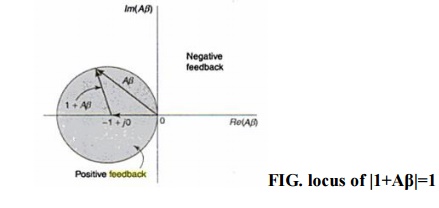Chapter: Electronic Circuits : Feed Back Amplifiers
Important Short Questions and Answers: Feed Back Amplifiers
FEEDBACK AMPLIFIERS
1. State
the nyquist criterion to maintain the stability of negative feedback amplifier
The nyquist criterion forms the basis of a
steady state method of determining whether an amplifier is stable or not.
Nyquist Criterion
The Aβ is a function of frequency. Points in
the complex plane are obtained for the values of Aβ corresponding to all values
of ‘f’ from -![]() to
to ![]() . The locus of all these points
forms a closed curve.
. The locus of all these points
forms a closed curve.
The criterion of nyquist is that amplifier is unstable if this curve encloses the point (-1+j0), and
the amplifier is stable if the curve does not enclose this point.

2. Define sensitivity and desensitivity of
gain in feedback amplifiers.
Sensitivity :The fractional change im amplification with feedback divided by the
fractional change im amplification
with out feedback is called the sensitivity of the transfer gain.

Desensitivity: Desensitivity is defined as the reciprocal of sensitivity. It
indicates the factor by which the
voltage gain has been reduced due to feedback network.
Desensitivity factor (D) = 1+A β.
Where A = Amplifier gain.
. β =
Feedback factor.
3.
What is the effect on input and output
impendence of an amplifier if it employs voltage series negative feedback?
When voltage series feedback is employed in an
amplifier, its input resistance increases and output resistance decreases.
4.
Define ‘feedback factor’ of a feedback
amplifier.
It is the ratio between the feedback voltages
to the output voltage of the amplifier.
β = Vf/ Vo
Where β is a feedback factor (or) feedback
ratio. Vf is the feedback voltage. Vo is the output
voltage.
5. What
is the impact of negativefeedback on noise in circuits?
When negative feedback is employed in an
amlifier ,the noise is reduced.
Let N= noise without feedback
Nf = noise with feedback
The noise with feedback is given by the
following relation

From above equation it is clear that when the
feedback is applied the noise is reduced by a factor (1+Aβ)
6. What is
the effect on input and output impendence of an amplifier if it employs current
shunt negative feedback?
When current
shunt feedback is employed in an amplifier, its input resistance decreases
and output resistance increases.
7. What is
return ratio of feedback amplifier?
A path of a signal from input terminals through
basic amplifier, through the feedback network and back to the input terminals
forms a loop. The gain of this loop is the product of –Aβ. This gain is known
as loop gain or return ratio. Here the minus sign indicates the negative
fedback.
8.
Justify that negative feedback amplifier increases bandwidth.
When negative feedback is employed in an
amlifier ,the bandwidth is increased. Let BW= bandwidth without feedback
BWf = bandwidth with feedback
The bandwidth with feedback is given by the
following relation,
BWf=BW(1+Aβ)
From above equation it is clear that when the
feedback is applied the bandwidth is increased is by a factor (1+Aβ)
9.
Distinguish between series and shunt feedback amplifiers Series feedback:
(i). In series feedback amplifier the feedback
signal is connected in series with the input signal.
(ii). It increases the input resistance.
Shunt
feedback:
(i). In shunt feedback amplifier the feedback
signal is connected in shunt with the input signal.
(ii). It decreases the input resistance.
10. What is current-series feedback amplifier. (or)
What is transconductance amplifier?
In a current series feedback amplifier the
sampled signal is a current and the feedback signal (Which is fed in series)is
a voltage.
Gm =Io / Vi
Where Gm = Amplifier gain.
Io = Output current.
Vi =
Input voltage.
11.
List the four basic feedback topologies.
ü Current series feedback.
ü Current shunt feedback.
ü Voltage series feedback
ü Voltage shunt feedback
12.
List the characteristics of an amplifier which
are modified by negative feedback.
·
It
reduces the gain of an amplifier
·
It
increases the stability of an amplifier.
·
It
increases the bandwidth
·
It
decreases noise and distortion
13. What
is Feedback Amplifier? & draw the diagram.
An amplifier with feedback network is known as
dfeedback amplifier. With the help of feedback network, ‘a portion of the
output signal is fedback to the input & combined with the input signal to
produce the desired outputs’
14.
Mention the three networks that are connected
around the basic amplifier to implement the feedback concept.
The three networks that are connected around
the basic amplifier to implement the feedback concept are
ü Mixing Network
ü Sampling Network
ü Feedback Network
15.
What happens to the input resistance based on
the type of feedback in an amplifier?
·
If the
feedback signal is added to the input in series
with the applied voltage, it increases
the input resistance.
·
If the
feedback signal is added to the input in shunt with the applied voltage, it decreases the input resistance.
16. What
are the steps to be carried out for complete analysis of a feedback amplifier?
Step 1 :
Identify the topology
Step 2,3: Find input and output circuit
Step 4 :
Replace transistor by its h-parameter equivalent circuit
Step 5 :
Find open loop voltage gain
Step 6 :
Indicate V0 and Vf and calculate β
Step 7 :
Calculate D, Avf, Rif, Rof and Rof.
Related Topics